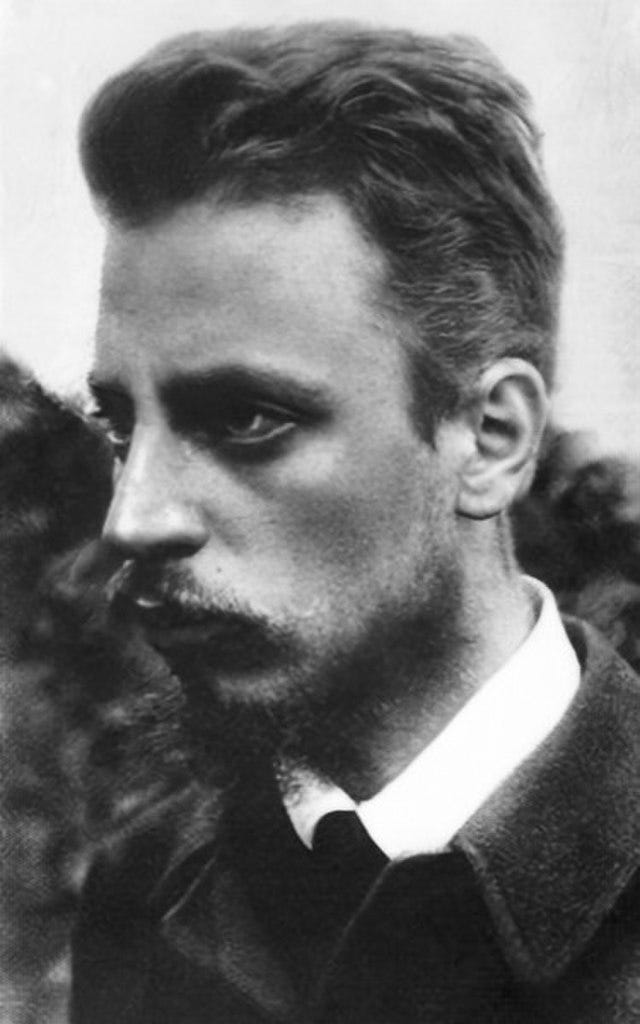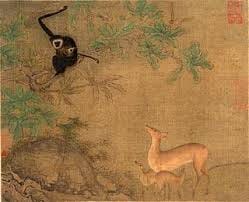The Wendeng, The Open, and The Mythogenic Zone (Part 2)
In the first part of this essay, I introduced Rainer Maria Rilke’s concept of "Weltinnenraum," or World-Inner-Space, as a radical re-imagining of how meaning is initiated through poetry (or any art): not as an external given, but as a dynamic interiority where the world is transmuted through the poet's act of "inwarding" and praise. Continuing our exploration of Rilke’s profound poetic philosophy, this second part delves into his concepts of “Wendeng” and “Das Offene.” We'll then draw parallels with Joseph Campbell's “mythogenic zone,” exploring how these ideas offer a vital approach to making meaningful art in the modern world
Rilke, 1900
The "Wendeng": Rilke's Pivotal Turn
The genesis of "Weltinnenraum" can be traced directly to Rilke’s "Wendeng"—German for “turn,” “turning point,” or “change.” This term signifies a crucial artistic and personal transformation, which he described in his 1914 poem with the same name.
This poem, and the concept it embodies, mark an essential shift from his earlier focus on “looking” at external objects and scenes with the utmost intensity to a new emphasis on “heart-work” and the profound internalization of the world. As he articulated this imperative in "Wendung":
The work of the eye is complete now; work next the heart's work— on those images you've captured within you, led in and overcome and left unknown.
Following the revolutionary New Poems, published in 1907, and the publication of his only novel, the strange and beautiful The Notebooks of Malte Laurids Brigge, Rilke experienced years of deep artistic crisis and depression. The passage above articulates Rilke’s artistic breakthrough following this period: the external “looking” had now to give way to an internal process of understanding, accepting, and transforming the images found within through the work of the heart. The “heart-work” is about loving and fully integrating these internalized experiences. Rilke had looked enough. Now it was time for what he had seen to change him.
The "Wendeng" thus represents a necessary aesthetic reorientation that allowed him (after the terrible period of WWI) to eventually complete the Duino Elegies and Sonnets to Orpheus in an astonishing few weeks. These few weeks, after years of silence and struggle, enabled Rilke to receive the majority of the Elegies and the Sonnets as if they were dictated to him. He had done his heart-work and fully activated his inner-world-space.
Rilke's Dinggedichte, poems of things, challenged the established hierarchy of Being by presuming the self-sufficiency of objects. By writing of the object as if from within, the poet deliberately rejected the presumptive duality of Cartesian logic. The object, in its written form, serves to de-center the human subject. The authentic possibility of this de-centering hinges, of course, on one’s view of the imagination’s boundaries, and whether the self can, indeed, be so de-centered.
Even if ultimately judged inauthentic, writing from such a position powerfully exercises the possibilities inherent in post-humanist perspectives. This was Rilke's method of approaching and revisiting and moving deeper into a subject. Writing was inwarding. William H. Gass, in the book he wrote about writing about Rilke, and Rilke writing, and writing itself, in which he writes about himself in the third person as he details his frustrations in translating Rilke, compared Rilke’s mode of being to the famous injunction of William James: "try to be someone on whom nothing is lost."
"Das Offene": The Unmediated Reality
In Rilke's poetry, particularly in the Duino Elegies, "Das Offene" (often translated as "the Open" or "the Openness") is a profound and elusive concept, closely related to, yet distinct from, "Weltinnenraum."
While "Weltinnenraum" emphasizes the internalization and transformation of the world within human consciousness, "the Open" refers to a boundless, unconditioned, and unmediated reality that animals instinctively inhabit but from which humans are for the most part estranged.
Key Characteristics of "The Open":
Animal's Realm: Rilke famously describes "the Open" as the realm of animals. In the Eighth Elegy, he writes:
With all its eyes the creaturely world looks out into the Open. Only our eyes are turned backward, and surround plant, animal, child like traps, as they emerge into their freedom.
Painting of gibbons and deer by unknown artist of Southern Song Dynasty. Ink and color on silk
Unmediated Reality: For the animal, there is no separation between inner and outer, no "world" as an object outside itself. The animal is simply in the Open, immersed in an undivided reality. It sees directly, without the filtering lens of human thought, language, or future-oriented consciousness.
Freedom from Death-Consciousness: A crucial aspect of the animal's experience in "the Open" is its freedom from the human awareness of death. Rilke states that "The free animal / always has its demise behind it / and before it God, and when it moves, it moves / in Eternity, like a running spring." For the animal, death is not a future event to be feared or contemplated; it's simply a part of its being, always behind it, allowing it to live purely in the present.
Human Estrangement: Humans, unlike animals, are "turned around." We see the world as objects, as something separate from us. We are constantly aware of our mortality and project meaning onto the future. This consciousness, while granting us unique capabilities, also alienates us from the direct, unmediated experience of "the Open" that animals possess. We create the world (exactly what we are so often told is the “real” world) in the sense of a constructed reality, often obscuring the pure "Open."
Occasional sight for Humans: While generally alienated, Rilke suggests that humans can sometimes have glimpses of "the Open," particularly in moments of intense love, childhood innocence, or near-death experiences. These are moments when the self-consciousness and separation temporarily dissolve.
The "Weltinnenraum" also has a nuanced connection to Rilke's concept of “Das Offene.” The concept of "Wendeng" provides the method by which the human can engage with the Weltinnenraum. If Weltinnenraum is the space where the world is interiorized, the "Wendeng" is the active process of turning inward to perform this transformation. It's how humans, who are estranged from "the Open" that animals inhabit, can still attempt a kind of wholeness and immanent transcendence by deeply engaging with and transforming their experience of the world from within. "The Open" then represents an ideal state of being, a unity with existence free from the divisions of false consciousness. Through poetry and art, however, the individual can find momentary connections with that unity.
Liberating Perception from Impermanence: Secular Transcendence
This concept is also intimately related to Rilke's incessant confrontation with death and transience. By transforming phenomena into this inner space, they are, in a fundamental sense, liberated from physical impermanence. Death has a different kind of residence in this inner world of varied landscapes.
While deeply mystical, "Weltinnenraum" is quite distinct from conventional religious transcendence. The divine or eternity is not discovered in some separate, otherworldly domain, but rather within a transformed immanence of the world itself. This might not have been only the kingdom of heaven Christ proclaimed was within us. The inner world also contained the land of Lament, which the poet would walk through in the last Duino elegies.
Rilke’s concept, then, offers more than a concept for philosophical consideration. It provides a working framework for understanding how meaning can be generated dynamically from within. An internal genesis.
For paid subscribers, this essay continues as we relate Rilke's poetic philosophy with Joseph Campbell's seminal work on myth. We will explore the parallels between Rilke's "Weltinnenraum" and Campbell's "mythogenic zone," and discover how we can continue to create meaning in our strange world and time.
Keep reading with a 7-day free trial
Subscribe to Continuum to keep reading this post and get 7 days of free access to the full post archives.





